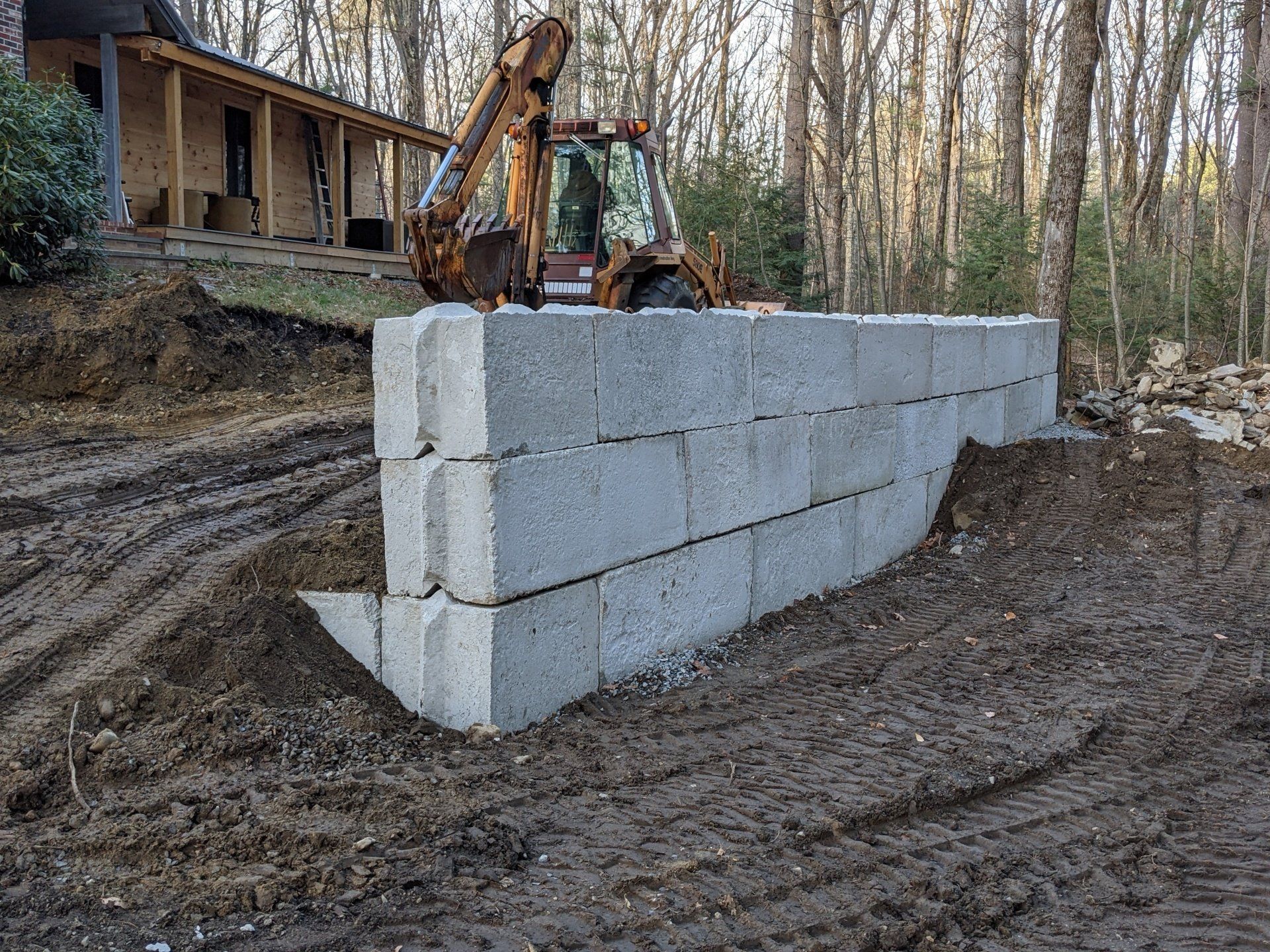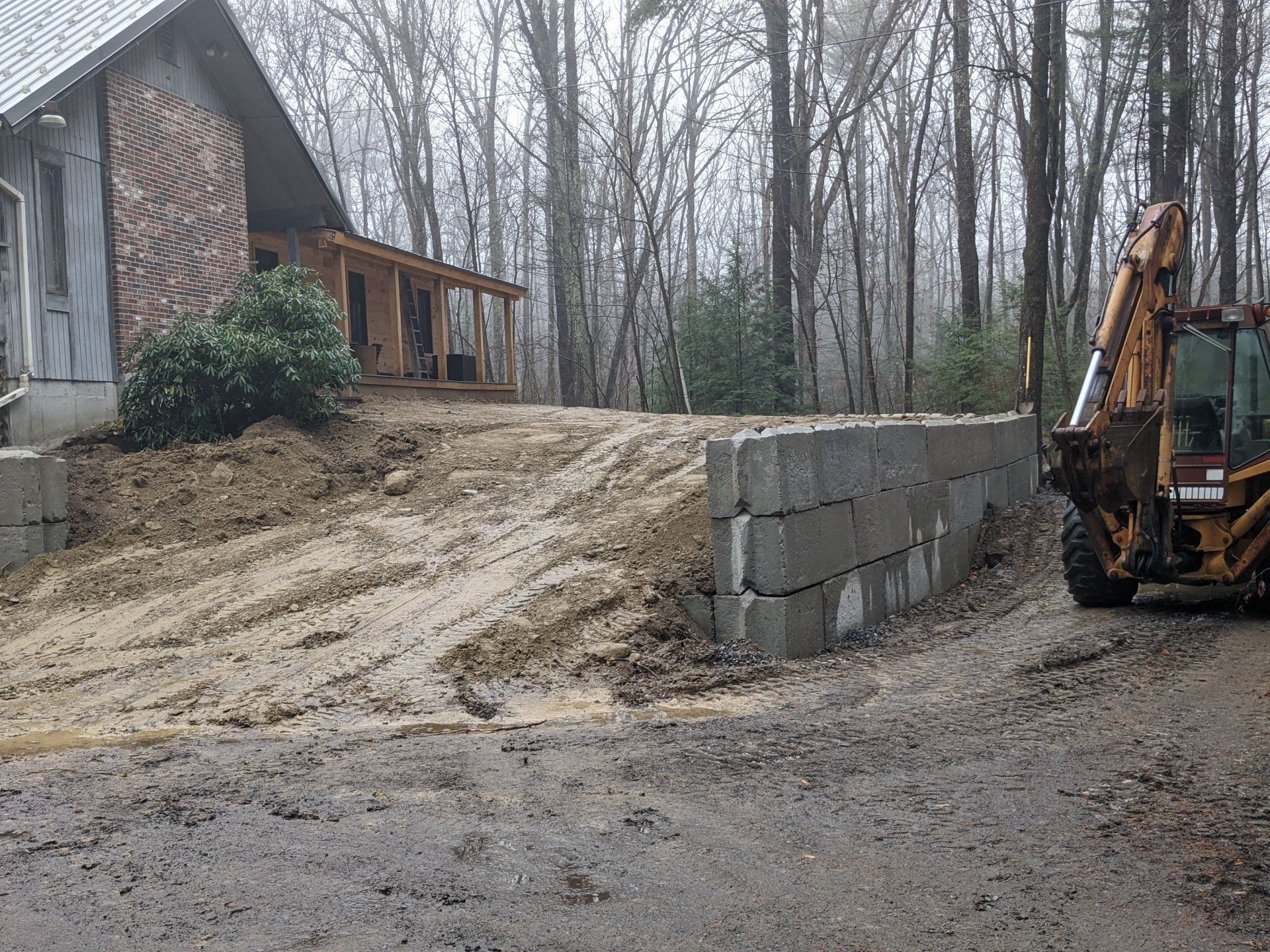Retaining Wall Pepperell MA
Struggling With Erosion, Sloping Yards, or Unstable Soil?
If your property in Pepperell MA suffers from sloping land, soil erosion, or uneven outdoor spaces, it’s more than just an eyesore—it’s a risk to your home’s foundation and landscape. Without a sturdy retaining wall, soil can slide, yards can flood, and outdoor spaces become unusable. Worse, improper drainage or weak retaining walls can lead to costly repairs down the line.
Don’t Let Poor Landscaping Drain Your Wallet
Ignoring unstable slopes can lead to structural damage, drainage issues, and even property value loss. Erosion doesn’t just affect soil—it can crack driveways, flood basements, and ruin landscaping. Many homeowners try quick DIY fixes, but without proper reinforcement, these temporary solutions fail under heavy rain or seasonal freeze-thaw cycles. That’s why investing in a professionally built retaining wall isn’t just a cosmetic upgrade—it’s protection for your property.
The Smart Solution: Durable, Professionally Installed Retaining Walls in Pepperell MA
At Silva Excavating, we design and build strong, lasting retaining walls tailored to the unique terrain of Pepperell MA. Whether you need a small decorative wall for your garden or a large structural wall for hillside stabilization, our team uses high-quality materials and expert craftsmanship to deliver results that last for decades.
Why Choose Silva Excavating for Retaining Wall Services in Pepperell MA?
✅ Engineered Strength: We use premium materials—stone, concrete blocks, poured concrete, or timber—to ensure every wall stands up to New England’s toughest weather.
✅ Enhanced Curb Appeal: Our retaining walls blend function and beauty, adding character to your landscape while protecting your property.
✅ Complete Drainage Solutions: Built-in drainage systems prevent water buildup and soil pressure, reducing long-term maintenance.
✅ Full Customization: Whether you want sleek modern concrete or rustic natural stone, we customize the wall to match your style.
✅ Safe and Code-Compliant Installations: For taller or structural walls, we collaborate with engineers and handle permitting so you don’t have to.
Popular Retaining Wall Types We Install in Pepperell MA
✅ Poured Concrete Walls
Ideal for a clean, modern look and superior strength. Perfect for large walls that need maximum reinforcement.
✅ Segmental Block Walls
Interlocking concrete blocks with no mortar required. Great for gardens, terraces, and decorative accents.
✅ Natural Stone Walls
A timeless, rustic appeal using fieldstone or boulders. Excellent for blending into natural landscapes.
✅ Timber Walls
Affordable and fast to install, timber retaining walls are a good option for smaller projects with a cozy, natural look.
Key Benefits of Installing a Retaining Wall
- Prevents soil erosion and protects foundation integrity
- Creates more usable yard space for gardens or patios
- Controls water drainage, reducing the risk of flooding
- Adds value to your home with beautiful, functional landscaping
- Long-lasting structure that reduces future maintenance costs
When Should You Replace or Repair a Retaining Wall?
✔️
Leaning Wall: Visible tilting caused by poor drainage or weak foundation.
✔️
Cracks & Splitting: Deep cracks signal structural failure—especially dangerous in concrete walls.
✔️
Bulging or Bowing: This indicates water pressure or poor anchoring.
✔️
Erosion Behind Wall: Water pooling or soil washing away means the drainage needs immediate attention.
If you notice any of these signs, it’s time to call the experts before minor issues turn into major expenses.
Ready to Fix Your Yard? Start With a Free Estimate!
At Silva Excavating, we don’t just build walls—we build peace of mind. Whether you need installation, repair, or replacement of your retaining wall, we’re the trusted experts in Pepperell MA. Every project starts with a free consultation and a no-pressure quote.
📞 Call us today or fill out our online form to schedule your free estimate.
It is possible to increase the value of your house by installing or renovating the retaining walls on your property. When constructing a retaining wall, materials and installation quality are the most important considerations. A well-built wall can resist the weather for many years. You may be asking about the many kinds of retaining walls that are available. Concrete, masonry, and stone are the most common materials used to construct retaining walls. There are a variety of materials to pick from depending on the location of the wall, the style you desire, and how long you intend the wall to remain. In locations with a slope, a retaining wall is necessary to keep dirt contained and in place. Patios and leisure spaces may be separated off by retaining walls in residential backyards. In addition, they may be utilized to build useful roadways by restraining the dirt. It's not an easy task to build a retaining wall on your property, and you want it to survive as long as possible. You may use this information to help you choose the ideal retaining wall for your situation.
What is a Retaining Wall?
A retaining wall is a structure that has been designed and built to hold or keep back soil. There is a wide variety of materials that may be used to construct retaining walls. Examples of these materials include poured concrete, concrete blocks, pebbles, boulders, or treated timbers. All of them can hold soil, however, some of them are simpler to use than others and some of them have shorter lifespans.
Concrete and Masonry Retaining Walls
Retaining walls made of poured concrete are the strongest and longest-lasting. Depending on your preferences, it may also be carved and shaped to resemble mortared stone. When space is an issue, poured concrete walls are the only form of retaining wall that isn't constructed to be battered (leaned back) against the soil. Another option is to use interlocking concrete blocks, which may be easily constructed by do-it-yourselfers. The rough surface gives the blocks a quarried appearance even though they are constructed of concrete. There is no need for the mortar to put them together because of how they are made. Mortar or no mortar, a mason is needed to construct masonry retaining walls correctly. When constructed correctly, they may survive up to forty years or more.
Choosing Retaining Wall Materials
When selecting the materials for your brand-new retaining wall you should always go for the highest possible quality that you can afford. The better the materials, the longer the wall will continue to serve its purpose (and the safer it will be as well). Keep in mind that a retaining wall's job is to prevent large amounts of dirt from falling over, thus you should only use the very best building materials. If the height of your retaining wall will be more than three feet, you are required to work with an engineer and you may also be required to get a permit. Your decision about the material will be heavily influenced by aesthetic considerations. For example, if you want the wall to have a contemporary and sophisticated vibe, you should consider using poured concrete rather than stone.
When must a Retaining Wall be Replaced?
There comes a time when retaining walls, although they might often survive for decades, need to be changed. If you see any of the following indicators, it is time to begin planning the construction of a new wall since the material used to construct the wall has been compromised:
- The leaning is often the result of tree roots, inadequate drainage, or an inadequate footing.
- Cracking is a symptom of structural degradation. Small cracks may be repaired, but cracks that are more than a quarter of an inch broad and deep and more than two feet long are cause for concern.
- The presence of sagging is an indication that the footing has been compromised in a particular location. The damaged portion of the wall could be able to be rebuilt by a trained expert, but depending on the severity of the damage, the whole wall might have to be rebuilt or replaced.
- The presence of bulging is an indication that there is a buildup of water pressure behind the wall, or in the case of interlocking blocks, that there is a lack of anchoring. The wall could be salvageable with careful excavation, but it might also need to be rebuilt.
🔗Explore More Excavating Services
●🛠️Excavation Pepperell MA
● 🛠️Retaining Wall Pepperell MA
●🛠️Septic Install Pepperell MA
●🛠️Drainage Pepperell MA
●🛠️Site Work Pepperell MA
●🛠️Land Clearing Pepperell MA
FAQ: Retaining Wall Pepperell MA
How long does a retaining wall last?
A properly installed retaining wall can last 30-50 years, depending on the material and drainage system.
Do I need a permit for a retaining wall in Pepperell MA?
Generally, retaining walls over 3-4 feet require a permit. We handle all necessary permits and code compliance.
What is the strongest type of retaining wall?
Poured concrete and reinforced stone walls offer the most strength and longevity, especially for large or high-load areas.
How much does a retaining wall cost in Pepperell MA?
Costs vary based on size, material, and location. On average, small decorative walls start at $3,500, while larger structural walls can range from $8,000 to $25,000+.
Can you repair an old retaining wall?
Yes! We offer retaining wall repairs and reinforcements, but if the wall is beyond repair, we’ll recommend cost-effective replacement options.
Silva Excavating – Building strong, beautiful retaining walls for every home in Pepperell MA.



